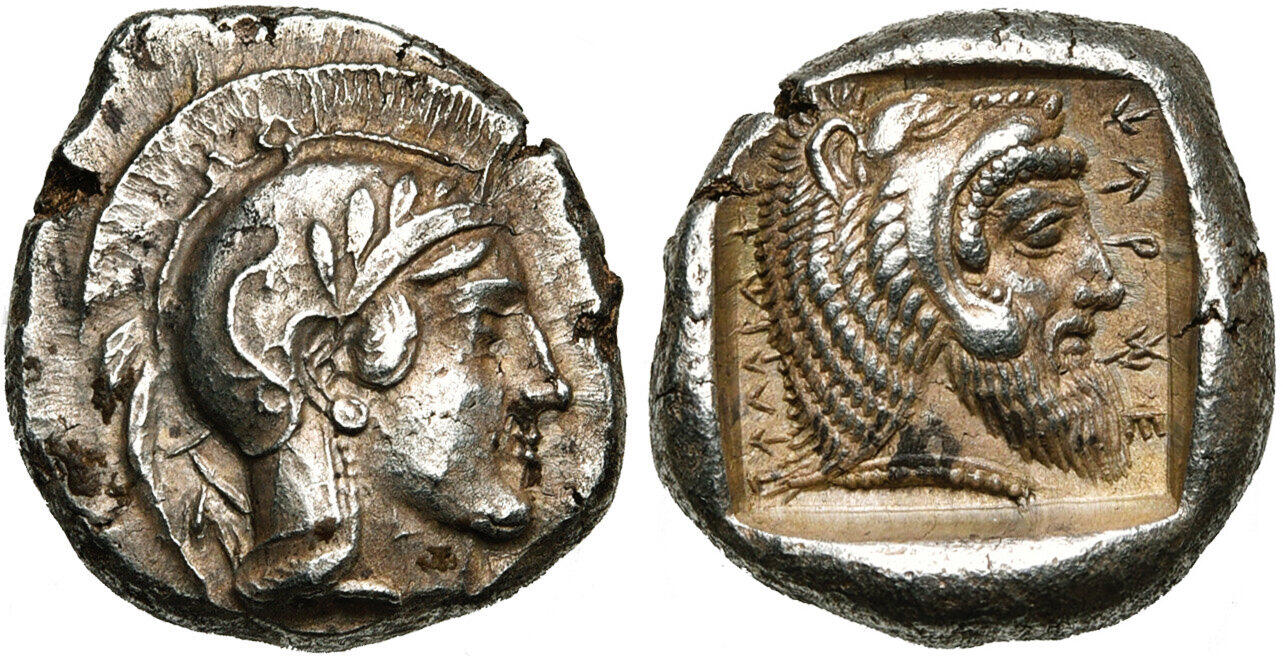Lycia (uncertain mint) (Kherei), silver, staters (Athena/satrap) (425-400 BCE)
From SILVER
425 BCE - 400 BCE Silver 5,010 kg
Description
| ObverseInscription or printing placed on the obverse.: | Athena on the right, wearing an Attic helmet. Behind the neck, Lycian character. |
| ReverseInscription or printing placed on the reverse.: | (Lycien).Heracles, right, wearing lion's headdress. On either side, in Lycian characters, Kherei Telebehihe. All within a hollow square. |
Mint and issuing power
| MintIdentifies the place of manufacture or issue of a numismatic object.: | Lycia (uncertain mint) | Ancient regionAncient region.: | Lycia | Modern countryModern country: Turkey | AuthorityIdentifies the issuing power. The authority can be "pretended" when the name or the portrait of X is on the coin but he/she was not the issuing power. It can also be "uncertain" when there is no mention of X on the coin but he/she was the issuing power according to the historical sources: | Kherei (dynast of Lycia, c. 430-410 BC) |
Chronology
| FromIdentifies the initial date in a range assigned in a numismatic context. | 425 BCE | toIdentifies the final date in a range assigned in a numismatic context.. | 400 BCE | PeriodTime period of the numismatic object.: Classical 480-323 BC |
Physical description
| MetalThe physical material (usually metal) from which an object is made.: | Silver |
Median weightMedian of the weights of numismatic objects (in grams). in grams | 8.40 | DenominationTerm indicating the value of a numismatic object. Examples: tetradrachm, chalkous, denarius.: | stater |
StandardStandard.: |
Image

AC266 Kherei.jpeg [1]
References
| Die study referencePublication of the study: | Mørkholm - Zahle 19761Mørkholm - Zahle 1976 | ||
| Coin series referenceReference to coin series study: | Sear II2Sear II, n° 5211, RQEMAC3RQEMAC, n° 266 | ||
| Coin series web referenceCoin series web references: | |||
Obverse dies distribution
| FrequencyFrequency of specimen in distribution. ᵖ | Number of obversesNumber of obverse dies. ᵖ (o) | % (o) | Number of coinsNumber of coins. (n) | % (n) | Die nameName(s) of the die(s). |
| 1 | 10 | 76.92 | 10 | 50 | 5, 8, 10, 11, 13, 14, 16, 17, 18, 19 |
| 2 | 1 | 7.69 | 2 | 10 | 9 |
| 4 | 2 | 15.38 | 8 | 40 | 12, 15 |
| Total | 13 of 13 | 99.99 | 20 of 20 | 100 |
Reverse dies distribution
no distribution is available
Quantification
| Number of obversesNumber of obverse dies. ᵖ (o) | 13 | Number of singletons (o1)The number of singleton coins. ᵖ | 10 |
| Number of reverse diesNumber of reverse dies. (r) | 17 | Number of coinsNumber of coins. (n) | 20 |
| Coins per obverse dieNumber of coins per obverse die. (n/o) | 1.54 | Coins per reverse dieNumber of coins per reverse die. (n/r) | 1.18 |
| Reverse per obverse ratioRatio of obverse dies divided by reverse dies. (r/o) | 1.31 | Percentage of singletons (o1)number of coins (n) divided by the number of singletons (o1) ᵖ | 76.92 % |
| Original number of dies (O) (Carter 1983 formula)The estimation of the number of coins according to Carter 1983 ᵖ | 29.82 | Coins struck if 20,000 as average productivity per dieCoins made if the average productivity for obverses (according to Carter) is 20,000. ᵖ | 596,400 |
| Original number of dies (O) (Esty 2011 formula)The estimation of the number of coins according to the singleton formula in Esty 2011 ᵖ (O) | 37.14 | Survival rate if 20,000 as average productivity per dieSurvival rate if average productivity is 20,000. ᵖ | 0.00003 |
| Coverage (o = % of O) (Esty 1984 formula)Esty 1984 - coverage (% of O) ᵖ (o = % of O) | 50% | Die productivity if survival rate 1/2,000Average productivity if survival rate is 1/2,000. ᵖ | 1,341.38 |
| Weight of silver (in kg) if 20,000 coins per die (O = Carter formula)Carter 1983 * Median weight * 20000 (*10 if gold or electrum) ᵖ | 5,010 kg <br /> 5,010 kg | Die productivity if survival rate 1/5,000Average productivity if survival rate is 1/5,000. ᵖ | 3,353.45 |
Remarks
References
- ^ Morkholm, Otto - Jan, Zahle (1976), "The coinages of the Lycian dynasts Kheriga, Kherei and Erbbina", Acta Archaeologica 47, p. 47-90, 3 pls.
- ^ Sear, David R. (1979), Greek coins and their values. Vol. II, Asia and North Africa, London, xlviii, p. 317-762
- ^ Callataÿ, François de (2003), Recueil quantitatif des émissions monétaires archaïques et classiques, Numismatique Romaine, Wetteren, VII + 267 p.